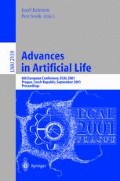Abstract
In this paper, locomotion of a biped robot operating in a physics-based virtual environment is evolved using a genetic algorithm, in which some of the morphological and control parameters of the system are under evolutionary control. It is shown that stable walking is achieved through coupled optimization of both the controller and the mass ratios and mass distributions of the biped. It was found that although the size of the search space is larger in the case of coupled evolution of morphology and control, these evolutionary runs outperform other runs in which only the biped controller is evolved. We argue that this performance increase is attributable to extradimensional bypasses, which can be visualized as adaptive ridges in the fitness landscape that connect otherwise separated, sub-optimal adaptive peaks. In a similar study, a different set of morphological parameters are included in the evolutionary process. In this case, no significant improvement is gained by coupled evolution. These results demonstrate that the inclusion of the correct set of morphological parameters improves the evolution of adaptive behaviour in simulated agents.
Access this chapter
Tax calculation will be finalised at checkout
Purchases are for personal use only
Preview
Unable to display preview. Download preview PDF.
References
Benbrahim, H., Franklin, J. A.: Biped Dynamic Walking Using Reinforcement Learning. In: Robotics and Autonomous Systems 22: (1997) 283–302.
Bongard, J. C., Paul, C.: Investigating Morphological Symmetry and Locomotive Efficiency using Virtual Embodied Evolution. In: J.-A. Meyer et al (eds.), From Animals to Animats: The Sixth International Conference on the Simulation of Adaptive Behaviour: (2000) 420–429.
Brooks, R. A., Stein, L. A.: Building Brains for Bodies. In: Autonomous Robots 1:1 (1994) 7–25.
Chocron, O., Bidaud, P. Evolving Walking Robots for Global Task Based Design. In: Proceedings of the IEEE Congress on Evolutionary Computation. (1999) 405–412.
Conrad, M.: The Geometry of Evolution. In: Biosystems 24: (1990) 61–81.
Fukuda, T., Komota, Y., Arakawa, T.: Stabilization Control Of Biped Locomotion Robot Based Learning With GAs Having Self-Adaptive Mutation And Recurrent Neural Networks. In: Proceedings of 1997 IEEE International Conference on Robotics and Automation. (1997) 217–222.
Gallagher, J.C., Beer, R.D, Espenschied, K.S., Quinn, R.D.: Application of Evolved Locomotion Controllers to a Hexapod Robot. In: Robotics and Autonomous Systems 19: (1996) 95–103.
Gruau, F., Quatramaran, Cellular Encoding for Interactive Evolutionary Robotics. Technical Report, University of Sussex, School of Cognitive Sciences, Brighton, UK. (1996)
Jakobi, N.: Encoding Scheme Issues for Open-Ended Artificial Evolution. In: Parallel Problem Solving from Nature IV, Springer-Verlag, Berlin, (1996) 52–61.
Juárez-Guerrero, J., Muñoz-Gutiérrez, S., Mayol Cuevas, W. W.: Design of a Walking Machine Structure using Evolution Strategies. In: IEEE Intl. Conf. on Systems, Man and Cybernetics. (1998) 1427–1432.
Komosinski, M., Ulatowski, S.: Framsticks: Towards a Simulation of a Nature-Like World, Creatures and Evolution. In: Proceedings of Fifth European Conference on Artificial Life. Springer-Verlag, Berlin, (1998) 261–65.
Kun, A., Miller, W. T. III: Adaptive Dynamic Balance of a Biped Robot using Neural Networks. In: Proceedings of the IEEE International Conference on Robotics and Automation. (1996) 240–245.
Lichtensteiger, L., Eggenberger, P.: Evolving the Morphology of a Compound Eye on a Robot. In: Proceedings of the Third European Workshop on Advanced Mobile Robots. Piscataway, NJ. (1999) 127–34.
Lipson, H., Pollack, J. Automatic Design and Manufacture of Artificial Life-forms. In: Nature 406 (2000) 974–78.
Lund, H. H., Hallam, J., Lee. W.-P.: Evolving Robot Morphology. In: Proceedings of of the IEEE Fourth International Conference on Evolutionary Computation. IEEE Press (1997).
Mautner, C., Belew, R. K.: Evolving Robot Morphology and Control. In: Sugisaka, M. (ed.), Proceedings of Artificial Life and Robotics 1999 (AROB99), Oita (1999).
McGeer, T.: Passive dynamic walking. In: Int. J. Robotics Research 9:2 (1990) 62–82.
Pfeifer, R., Scheier, C.: Understanding Intelligence. MIT Press, Cambridge, MA (1999).
Reil, T., Husbands, P.: Evolution of Central Pattern Generators for Bipedal Walking in a Real-time Physics Environment. IEEE Transactions on Evolutionary Computation, submitted (2001).
Sims, K.: Evolving 3D Morphology and Behaviour by Competition. In: Artificial Life IV. MIT Press, Cambridge, MA (1994) pp. 28–39.
Ventrella, J.: Explorations of Morphology and Locomotion Behaviour in Animated Characters. In: Artificial Life IV. MIT Press, Cambridge, MA (1996) 436–441.
Vukobratovic et al.: Biped Locomotion: Dynamics, Stability, Control and Applications. Springer Verlag, Berlin (1990).
Author information
Authors and Affiliations
Editor information
Editors and Affiliations
Rights and permissions
Copyright information
© 2001 Springer-Verlag Berlin Heidelberg
About this paper
Cite this paper
Bongard, J.C., Paul, C. (2001). Making Evolution an Offer It Can’t Refuse: Morphology and the Extradimensional Bypass. In: Kelemen, J., Sosík, P. (eds) Advances in Artificial Life. ECAL 2001. Lecture Notes in Computer Science(), vol 2159. Springer, Berlin, Heidelberg. https://doi.org/10.1007/3-540-44811-X_43
Download citation
DOI: https://doi.org/10.1007/3-540-44811-X_43
Published:
Publisher Name: Springer, Berlin, Heidelberg
Print ISBN: 978-3-540-42567-0
Online ISBN: 978-3-540-44811-2
eBook Packages: Springer Book Archive

